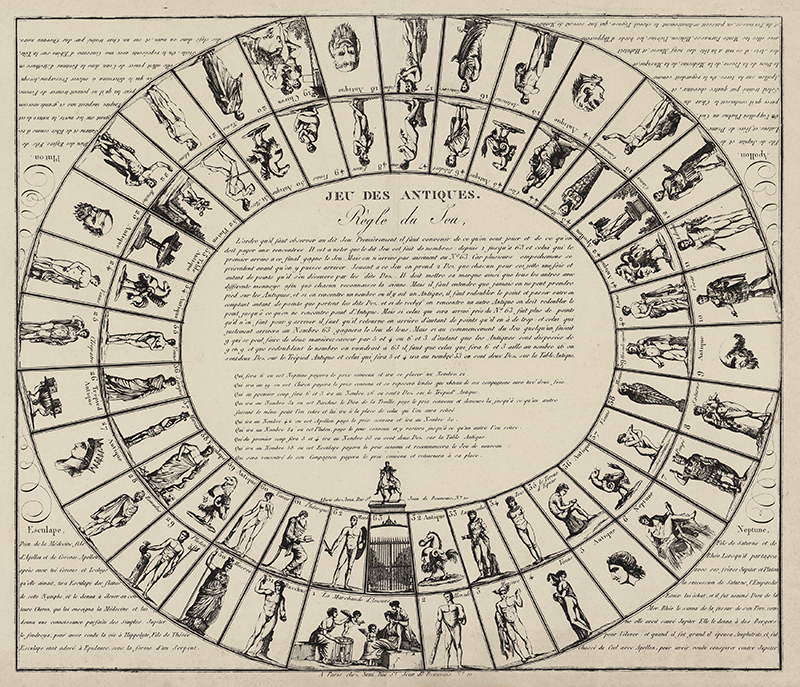
19th, 20th & 21st Century Fine Prints
707-546-7352 · fax 707-546-7924 · web: www.annexgalleries.com · email: artannex@aol.com
Jeu des Antiques (Antiques Game; game-of-the-goose board game) by Chez Jean, Paris

Jeu des Antiques (Antiques Game; game-of-the-goose board game)
Chez Jean, Paris
Jeu des Antiques (Antiques Game; game-of-the-goose board game)
The publisher of this game, the multi-generational family firm of Pierre Jean, appears in the Bibliographie de France from 1811 to 1838 at this address. The text is in French, including the publisher's address: Paris: chez Jean, rue St. Jean de Beauvais, No. 10. Published circa 1820, this engraved game board was printed on a sheet measuring 19-1/2 by 22-1/2 inches, the platemark measuring 17-1/8 by 22-5/16 inches.
An early nineteenth-century French table game freely inspired by classical antiquity. A variation on the traditional jeu de l’oie, or "game of the goose," the board features a spiral track of sixty-three spaces decorated with gods and heroes, centaurs and fauns, statuary and sarcophagi, as well as historical figures including Caesar, Cleopatra, Seneca, and Plutarch.
Rolling dice to chase one another around the track, subject to the penalties outlined in the center of the board, players could brush up on their mythology, archaeology, and art history as they raced. The "opening" space, La Marchande d’Amours (bottom center-left):
"...references a recently excavated fresco at the Villa Arianna, south of Pompeii, a subject made fashionable by contemporary artists like Joseph-Marie Vien and Francesco Bartolozzi. No fewer than eight spaces on the board depict Venus in poses based on Greek and Roman sculpture, including the Venus Callipyge and the Crouching Venus. The game starts with a scene showing the figure of Amor (Cupid), Roman god of love, whereas the last god depicted is Mars, god of war. Other figures depicted in the game squares are: Bacchus, Hercules, Mercury, Venus (depicted several times in various instances), Clio, Faunus, Asclepius, Neptune, Saturn, Pompey, Marsyas, Julius Caesar, Numa Pompilius, Adonis, Lucius Cornelius Cinna , Ganymede, Apollo, Silenus, Chiron, Seneca, Plutarch, Cleopatra, Isis, etc.
"Some of the rules listed at the center of the game are: "- players who land on space 6 (Neptune) must advance to space 12; - players who land on space 19 (Chiron) will skip two turns; - players who land on space 42 (Apollo) will advance to 50; - for an initial throw of dice of 6 and 3, the player will land on "Antique" (9) and automatically advances to 26; - players who land on space 31 (Bacchus) will have to wait there until another player reaches the same space and then exchange places with them; - the classical "death" space on number 58 (Asclepius) forces the player to start the game again.
"The role of the geese in this game is played by various antique figures, present on spaces 5, 9, 14, 18, 23, 27, 32, 36, 41, 45, 50, 54, 59. As in all "games of goose", if a player lands on these spaces, they are allowed to move again, according to the number on the dice."
Literature: Henry-Renè d'Allemagne': "Le noble jeu de l'oie en France, de 1640 à 1950," Paris 1950. (page 221).


